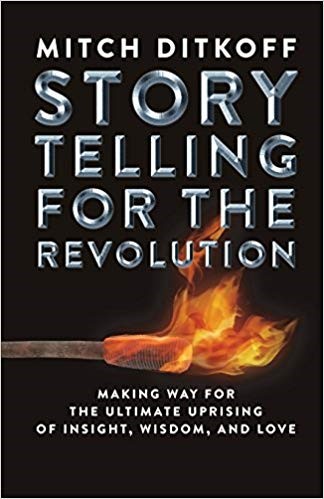How to Deliver a Meaningful, Memorable Message Quickly

HINT: It has nothing to do with pep talks, powerpoint shows, case studies, statistics, data, performance reviews, carrots, or sticks. Give up?
Stories. That's right. Stories. Storytelling, done well, is the most effective way to deliver a meaningful, memorable message. It's been going on since the Stone Age. Why? Because it works.
Here's my 5-minute talking head video on the topic.
25 quotes on storytelling
As it applies to teenage girls
One of my stories
Our storytelling workshop
Posted by Mitch Ditkoff at 01:36 PM | Comments (1)
February 27, 2015I Am Moving to a Blog Cabin

I see the future.
Everyone will have a blog. Every blogger's pet will have a blog. Every blog will have a blog. Every blog's blog will have a blog. No one will be reading any of these blogs because everyone will be too busy writing blogs. (Those with ADD will be tweeting).
Bloggers will occasionally visit other blogs, but only for the purpose of leaving comments that will direct readers back to their own blog.
Letter writing will become popular once again, gaining a new lease on life after the internet crashes repeatedly because of the profusion of blogs, tweets, and youtube videos created by 5-year olds, holographic spammers, robots, and terrorist groups.
Why all the blogging?
Because people want to connect. And WHY do people want to connect? Because there is a fundamental need inside each and every one of us to feel connected.
"Connected to WHAT?" is the question.
Most business leaders are likely to say something like "the marketplace," or "our customers" or "company values," but the real answer is far more fundamental -- your self.

Remember that? The part of you that doesn't have a title, a strategic plan, or a smart phone to keep it all together? That's where real communication begins -- from the inside out. And even more importantly, that's where the real experience of life begins.
Bottom line, for each of us to feel truly connected, we first need to connect with ourselves. Then, and only then, does it make sense to connect with others.
Otherwise, all our efforts to connect will be fundamentally flawed -- tinged with the slightly neurotic need for more approval, information, and virtual friends -- none of which are really necessary once we master the fine art of tapping into who we really are in the first place.
Sort of like putting the isness back in business.
And speaking of the future -- high rises are out. Blog cabins are in.
Idea Champions
Brainstorm Champions
My innovation-themed keynotes
Illustration: Sara Shaffer
Posted by Mitch Ditkoff at 05:32 PM | Comments (0)
February 22, 2015GUY WIRE: The Art of Innovation
Here is a no BS, engaging, entertaining, honorable 21-minute talk on innovation, by the extremely refreshing Guy Kawasaki. Many pearls of wisdom in this and some good jokes.
Posted by Mitch Ditkoff at 05:33 PM | Comments (0)
February 18, 2015The Idiot Savant's Guide to Sparking Innovation On the Job

Here's a common scenario: An acquaintance passes you on the street, stops, and asks how you're doing. You begin responding with some meaningful updates about your life, but the person asking you the question seems quite distracted -- surprised you are actually answering their question.
Their opening question to you is what's known as a "social nicetie" -- a polite, automated greeting with very little depth to it.
Business leaders do something similar. They ask their workforce for ideas, but when people actually respond, the business leader or manager acts as if they're late for an important meeting.
Here's my six-minute rant on the phenomenon.
Idea Champions
More grist for the mill
This will help
Posted by Mitch Ditkoff at 06:51 PM | Comments (0)
February 17, 2015On Being an Idea Champion

There's a reason why the expression "ideas are a dime a dozen" is so popular. Because they are. It's easy to get ideas. What's not so easy is championing ideas. And by "championing", I am referring to the kind of heroic commitment required to actually manifest those ideas. Here's my six-minute video elaboration on this often neglected topic. It's great that you have a new idea you care about. Wonderful. Now, ask yourself "What is it going to take for me to press through all the inevitable obstacles and bring this idea to life?"
Posted by Mitch Ditkoff at 07:34 AM | Comments (0)
February 13, 2015How to Foster a Culture of Innovation

Want a culture of innovation? Choose a few of the following guidelines and make them happen. If not YOU, who? If not NOW, when?
1. Remember that innovation requires no fixed rules or templates -- only guiding principles. Creating a more innovative culture is an organic and creative act.
2. Wherever you can, whenever you can, always drive fear out of the workplace. Fear is "Public Enemy #1" of an innovative culture.
3. Have more fun. If you're not having fun (or at least enjoying the process) something is off.
4. Always question authority, especially the authority of your own longstanding beliefs.
5. Make new mistakes.
6. As far as the future is concerned, don't speculate on what might happen, but imagine what you can make happen.

7. Increase the visual stimuli of your organization's physical space. Replace gray and white walls with color. Add inspiring photos and art, especially visuals that inspire people to think differently. Reconfigure space whenever possible.
8. Help people broaden their perspective by creating diverse teams and rotating employees into new projects -- especially ones they are fascinated by.
9. Ask questions about everything. After asking questions, ask different questions. After asking different questions, ask them in a different way.
10. Ensure a high level of personal freedom and trust. Provide more time for people to pursue new ideas and innovations.
11. Encourage everyone to communicate. Provide user-friendly systems to make this happen.
12. Instead of seeing creativity training as a way to pour knowledge into people's heads, see it as a way to grind new glasses for people so they can see the world in a different way.
13. Learn to tolerate ambiguity and cope with soft data. It is impossible to get all the facts about anything. "Not everything that counts can be counted. Not everything that can be counted counts," said Einstein.
14. Embrace and celebrate failure. 50 to 70 per cent of all new product innovations fail at even the most successful companies. The main difference between companies who succeed at innovation and those who don't isn't their rate of success -- it's the fact that successful companies have a LOT of ideas, pilots, and product innovations in the pipeline.
15. Notice innovation efforts. Nurture them wherever they crop up. Reward them.
16. When you're promoting innovation in-house, always promote the benefits of a new idea or project, not the features.
17. Don't focus so much on taking risks, per se, but on taking the risks OUT of big and bold ideas.
18. Encourage people to get out of their offices and silos. Encourage people to meet informally, one-on-one, and in small groups.
19. Think long term. Since the average successful "spin-off" takes about 7.5 years, the commitment to innovation initiatives need to be well beyond "next quarter."
20. Create a portfolio of opportunities: short-term, long-term, incremental, and discontinuous. Just like an investment portfolio, balance is critical.
21. Involve as many people as you can in the development of your innovation initiative so you get upfront buy-in. This is the "go-slow now to go-fast later" approach. (The opposite approach of having a few people go off to a desert island and come back with their concept is almost always doomed to failure).
22. Improve the way brainstorming sessions and meetings are facilitated in your organization. Create higher standards and practices.

23. Make sure people are working on the right issues. Identify specific business challenges to focus on. Be able to frame these issues as questions that start with the words, "How can we?"
24. Communicate, communicate, communicate, communicate, communicate and then communicate again. Deliver each important message at least six times.
25. Select and install idea management software for your intranet. (Or, if you've got an intranet and certain directories available to everyone, set up your own idea depository/database and make it as interactive as you want).
26. Don't focus on growth. Growth is a product of successful innovation. Focus on the process of becoming adept at taking ideas from the generation stage to the marketplace.
27. Make customers your innovation partners, while realizing that customers are often limited to incremental innovations, not breakthrough ones.
28. Understand that the best innovations are initiated by individuals acting on their own at the periphery of your organization. Don't make your innovation processes so rigid that they get in the way of informal and spontaneous innovation efforts. Build flexibility into your design. Think "self-organizing" innovation, not "command and control" innovation.
29. Find new ways to capture learnings throughout your organization and new ways to share these learnings with everyone. Use real-life stories to transfer the learnings.
30. Stimulate interaction between segments of the company that traditionally don't connect or collaborate with each other.
31. Develop a process of trying out new concepts quickly and on the cheap. Learn quickly what's working and what's not.
32. Avoid analysis paralysis. Chaotic action is preferable to orderly inaction.
33. Before reaching closure on any course of action, seek alternatives. Make it a discipline to seek the idea after the "best" idea emerges.
34. Know that attacking costs as a root problem solves nothing. Unreasonable costs are almost always a sign of more profound problems (e.g. inefficient structures, processes or training).
35. A great source of new ideas are people that are new to the company. Get new hires together and tap their brainpower and imagination.
36. Get customer feedback before committing resources to a product's development.
37. Seek diversity of viewpoints. Get people together across functions. A diversity of views sparks more than conflict -- it sparks innovation.
38. Invite outside partners early on when exploring new opportunities. Find ways for your company to partner with others and actively share ideas, technologies, and other capabilities.
39. Avoid extreme time pressures.
40. Don't make the center of your efforts to help people be more creative a physical "creativity center." Fold your innovation resources into your business units.
41. Don't make innovation the responsibility of a few. Make innovation the responsibility of each and every employee with performance goals for each and every functional area.
42. Give your people specific, compelling, and measurable innovation goals.

43. Try to get as much buy-in and support from senior leadership as you can while realizing that true change NEVER starts at the top. How often does the revolution start with the King?
44. Realize that "resource allocation" is the last bastion of Soviet-style central planning. Think of new innovation opportunities as "resource attractors."
45. Pay particular attention to alignment. Ensure that the interests and actions of all employees are directed toward key company goals, so that any employee will recognize and respond positively to a potentially useful idea.
46. Reward collective, not only individual successes, but also maintain clear individual accountabilities and keep innovation heroes visible.
47. Do your best to ensure that linear processes give way to networks of collaboration.
48. Remove whatever organizational obstacles are in the way of people communicating bold, new ideas to top management.
49. Systematize. Find problems (not only with products, but with processes, customer service, and business models) and solve them.
50. Drive authority downwards. Make decisions quickly at the lowest level possible.
What We Do
Culture of Innovation keynote
Culture of Innovation workshop
NOTE: This list co-authored with Val Vadeboncoeur
Posted by Mitch Ditkoff at 06:31 PM | Comments (19)
February 11, 2015The History (and Present) of Valentine's Day

Most people think Valentine's Day was invented by Hallmark Cards. It wasn't. Valentine's Day is actually a well-documented, historical phenomenon -- its tangled roots winding their way through centuries worth of Christian liturgy, pagan tradition, myth, and an occasional beheading.
The most popular account of its origins date back to a temple priest named, not surprisingly, Valentine, a later-to-be-canonized saint who was executed in 270 A.D. by Emperor Claudius II for performing illegal marriage ceremonies on the Roman battlefield. Back then, as the story goes, the military-minded Claudius believed connubial bliss was bad for war and made it illegal for soldiers to wed.
Imprisoned for his battlefield-betrothing ways, Valentine, a man of many talents, supposedly healed the blind daughter of his jailer while incarcerated and, the night before his execution, gave the newly sighted young lass a hand written card signed -- you guessed it -- "From Your Valentine."
And the rest, as they say, is history.
Of course, as in most historical accounts, there is almost an infinite variety of competing legends -- some religious, some pagan, some merely the result of bad translations by poorly educated scribes. According to the Catholic Encyclopedia, there were at least three early Christian saints named Valentine -- each of whom were martyred on February 14th. And to make matters even more Valetiney, the official Roman Catholic roster of saints lists no less than 12 saints named "Valentine."
Indeed, depending on where you live and what you believe, it is possible to celebrate St. Valentine's Day on six different days of the year -- November 3, January 7, July 25, July 6 being four of them. Me? I prefer February 14, not just because it's an American tradition, but because, where I live, February is ridiculously bleak and chocolate keeps my spirits (and blood sugar) high.

It wasn't until the 14th century, however, that Valentine's Day was associated with romantic love. And it was the English poet, Geoffrey Chaucer, who we have to thank for that. Chaucer's opus, Parliament of Foules, was the first ever to link the tradition of courtly love with St. Valentine's day.
Handwritten Valentine's Day cards were the tradition until 1847. That's when Esther Howland, a Mt. Holyoke graduate and budding entrepreneur, got the idea to mass produce them, ordering massive amounts of paper and lace from jolly old England, a country where no less than half the population was in the habit of giving and receiving Valentine's Day cards.
Thirty five hundred miles away, in the not-so-jolly United States, more than 190 million Valentine's Day cards are given each year -- and, if you count the number of cards school children give each other, that number skyrockets to one billion. With US citizens spending approximately $13.1 billion on Valentine's Day gifts each year, it's fair to say this love-themed holiday may be just as good for the economy as war is.
Fortunately, you don't have to be martyred, heal your daughter's jailer, or recite Chaucer's poetry to celebrate your loved ones this year. In addition to sending chocolate, roses, jewelry and cards, you can also send something digital, more specifically, the 5:23 music slide show featuring 23 inspired quotes on love by a selection of movers and shakers, none of whom, I believe, have ever been beheaded, healed the blind, or performed a single marriage ceremony on a Roman battlefield.
Also published in the Huffington Post.
Idea Champions
Posted by Mitch Ditkoff at 01:19 AM | Comments (1)
February 06, 2015BE WHO YOU ARE (everyone else is already taken)
My company, Idea Champions, is headquartered in a town that most people don't associate with corporate consulting -- Woodstock. Yes, THAT Woodstock -- the Woodstock the world has come to know and love as the geographical center of all things musical, alternative, holistic, and far out. It's been an interesting ride living here and then traveling, as I do, all over the world to do my corporate consulting thing.
Here's a 5-minute video of me telling a funny story about my little Woodstock secret coming out at a cocktail party in Munich, Germany. And here's the full story about it in the Huffington Post -- excerpted from my forthcoming book.
Idea Champions
More stuff I've written
The story workshop
Posted by Mitch Ditkoff at 12:54 AM | Comments (0)
February 04, 2015An Early Valentine's Gift for You
Some people say creativity is the key to innovation. Others say perseverance, teamwork, risk taking or R&D. I say LOVE. Yup, love. Without love, innovation shrivels and dies. Mozart has something to say about this, too. Anyway, Valentine's Day is just 10 days away and, since we know you are working your little tushie off and may not make the time to buy the ones you love a gift -- we are giving you this show to give to them. And if you feel like giving to our favorite charity for whom we are dedicating this show, that would be fantastic.
Posted by Mitch Ditkoff at 11:04 PM | Comments (0)
February 03, 2015The Secret to a Good TED Talk
Idea Champions
Ten Tips for Giving a Kick Ass Keynote
When Oversleeping Before a Keynote is the Right Thing to Do
Posted by Mitch Ditkoff at 11:22 PM | Comments (0)
The Idiot's Guide to Managerial Success in the 21st Century
Idea Champions
Brainstorm Champions
Posted by Mitch Ditkoff at 10:51 PM | Comments (0)
February 02, 2015CROSSING THE TEENAGE CHASM: The Power of Personal Storytelling

There are 16,593,242 teenage girls living in America. One of them lives in my house. That would be my daughter, Mimi, an extraordinary 17-year old who, shall we say, has been quite an education for me.
If you have a teenage daughter, you know what I mean. If you've been a teenage daughter, you know what I mean. If you have a friend with a teenage daughter (and spent hours chanting "It's just a phase she's going through, it too shall pass") you know what I mean. Everyone else -- oh ye of no teenagers in your life -- please give me the benefit of the doubt for a moment while I shed some major light on the little understood emerging science of how to communicate to a teenage girl.

Most people who know me would assume I'd have no trouble communicating to my teenage daughter. I'm smart. I'm likable. I'm laid back and usually thought of as "cool". I am also a professional communicator -- my work taking me all over the world to speak with all kinds of people: rocket scientists, MTV programmers, actuaries, college students, polymer chemists, PR wizards, cultural creatives, Hollywood executives, video game makers, and everybody else in between -- a percentage for whom English is their second language.
Compared to communicating to my teenage daughter, these people are a piece of cake.
Usually, my attempts to engage my daughter in meaningful conversation are perceived of as lame. I ask what I consider to be authentic, thoughtful, caring questions and, more often than not, get only inscrutable, one word answers -- "Fine", "Good", and "OK" being the three most popular, as she mounts the carpeted staircase to her room.
If I try to get clever in my conversation-opening mode, I succeed only in getting "the look" -- the non-verbal equivalent of "Yo, dude, I see through your game of trying to have a conversation with me and, God, why would I want to talk with anyone as old as you when, in fact, I have some serious texting and Netflix watching to do?"
But today... ah, today... driving Ms. Mimi to school was a Red Sea parting experience -- a glorious epiphany, free parking in Monopoly -- one of those Archimedes-in-the-bathtub moments we've all heard about.
Are you ready for the the secret to communicating to a teenage girl? STORY!
Yes, story! Today, instead of my pitiful, Socratically-infused, semi-desparate attempt to engage my still-not-yet-fully-formed-frontal-cortex-challenged daughter, I completely shifted gears. I took a left turn, instead of a right, segueing from something she said to the spontaneous telling of a personal story -- the passionate, no holds barred sharing of a life-changing moment, for me, that happened five years ago in Australia -- a moment when the eternal adolescent in me made a quantum leap.
I was not probing. I was not teaching. I was not "looking for an opening" to establish more rapport. I was merely recounting a story that mattered to me -- one, it turns out, that mattered to her, she being an edgy, aspiring artist who, like me, sometimes wrestles with doubt.
The vibe in the car? Totally transformed from the kind of teenage black hole moment where only a father's bald spot is visible to the sudden brilliance of a Christmas morning.
When my story was over, my daughter was not only fully present, engaged, and responsive... she asked ME questions. Here in this space, Mimi and I were one, two members of the same tribe sitting around the same fire, the light in each others' eyes all we needed to find our way home to ourselves and each other.
While there probably aren't a whole of teenage girls in your life right now, you, as a human being, entrepreneur, manager, team leader, worker bee, business owner, or freelancer, are faced with the same challenge every single day that millions of parents of teenage girls are faced with -- and that is how to how to BRIDGE THE GAP between you and "that other person"... how to connect... how to engage in a way that works.
May I suggest that STORY is the way to go -- the convertible, low-carbon emission vehicle that allows you to travel vast distances between others who may be very different from yourself. Story, quite simply, is the BRIDGE, the universally understood medium that makes it profoundly easy to deliver and receive a message in the least amount of time and in a way that is empowering, inspiring, and memorable.
What story will YOU tell this week? And who will you tell it to?
Idea Championshttp://www.ideachampions.com
Posted by Mitch Ditkoff at 11:00 AM | Comments (1)














